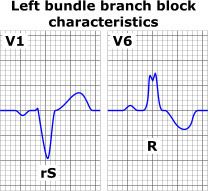ICD-10 I44.4 - I44.7 eMedicine ped/2501 | DiseasesDB 7352 | |
 | ||
Specialty Cardiology, Emergency Medicine | ||
Left bundle branch block (LBBB) is a cardiac conduction abnormality seen on the electrocardiogram (ECG). In this condition, activation of the left ventricle of the heart is delayed, which causes the left ventricle to contract later than the right ventricle.
Contents
Causes
Among the causes of LBBB are:
Diagnosis
The criteria to diagnose a left bundle branch block on the electrocardiogram:
The T wave should be deflected opposite the terminal deflection of the QRS complex. This is known as appropriate T wave discordance with bundle branch block. A concordant T wave may suggest ischemia or myocardial infarction.
There are also partial blocks of the left bundle branch: "left anterior fascicular block" (LAFB) and a "left posterior fascicular block" (LPFB). This refers to the bifurcation of the left bundle branch.
Diagnostic consequences
The presence of LBBB results in that electrocardiography (ECG) cannot be used to diagnose left ventricular hypertrophy or Q wave infarction, because LBBB in itself results in widened QRS complex, and changes in the ST-T segment consistent with ischemia or injury.
